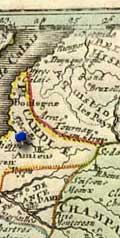Picardie.

The région lies just above Paris with its northern edge kissing the channel that separates England and France. The relatively flat land was well-suited for growing wheat, sugar beets, potatoes, and barley.
The Romans built a lattice of roads through the Chantilly forest where herds of deer attracted eager hunters.
The King was building palaces and decreed that the work be of French origin. Italy held the key to making large of sheets of glass but around 1665 Jean-Baptiste Colbert, French Minister of Finances, arranged for three Venetian glassworkers to come to Paris. This triggered an all out competition as Venice forbade any worker from plying their trade anywhere else so that they could retain the secrets to making glass. Rumor has it that the three who did go to France were poisoned to protect the Italian industry. In 1678 La Compagnie du Noyer in Saint-Gobain, Aisne, Picardie developed the technology to produce the glass for the many mirrors in the Palace of Versailles' Galerie des Glaces or Hall of Mirrors.
The renowned gothic cathedral Saint-Pierre de Beauvais was to be the largest in Europe, though was never completed. Even so, the vault of its quire is highly regarded. In Ponchon, the small church of Saint-Remi's interior walls were painted with beautiful frescoes, then were covered in whitewash, and only restored decades later.
Our ancestors who emigrated from Picardie are listed below. The dates reflect the year they arrived in Canada if known, otherwise it is the date of their earliest appearances in the records there:
- Anne-Antoinette de Liercourt (1651) of Beauvais.
- François Séguin (1665) of St-Aubin-en-Bray.
- Rémy Dupille (1666) of Ponchon.
- Noël Bulteau (1727) of Senlis.
- Marie-Marguerite Debuire (1727) of Amiens.
- https://www.britannica.com/place/Picardy
- https://en.wikipedia.org/wiki/Senlis
